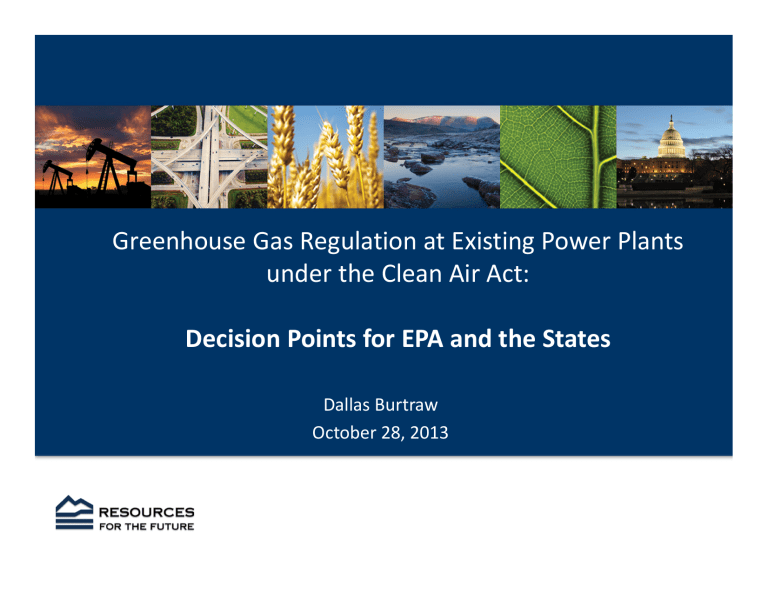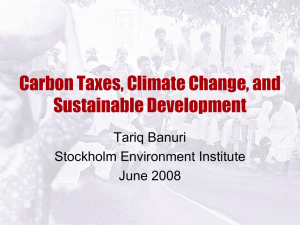Greenhouse Gas Regulation at Existing Power Plants

Greenhouse Gas Regulation at Existing Power Plants under the Clean Air Act:
Decision Points for EPA and the States
Dallas Burtraw
October 28, 2013
Useful Findings: (1) The Economic Perspective
•
CAA regulations could be stringent
‒ An emissions rate performance standard (tons/MWh) can achieve as many emissions reductions as cap and trade
•
CAA regulations could be cost effective
‒ A flexible approach (e.g. emissions rate averaging) can be efficient within the set of regulated sources
•
A flexible emissions rate performance standard would result in a small change in electricity price
•
This approach is not new
Useful Findings: (2) Program Design
•
An emissions rate performance standard has two key features:
‒ Is standard the same across units, or differentiated?
‒ Can you average (trade), and with whom?
•
States may want to implement an alternative design
‒ Some states already have cap and trade
‒ Many environmental advocates and some states and companies want to credit investments in renewables, transmission line upgrades or energy efficiency
•
These policies will reduce emissions (tons) but have a different effect on emissions rates (tons/MWh)
Decision Points: Timing
1. What is the schedule for EPA guidelines (proposed & final), state implementation plans, and compliance? [Decided]
‒ Draft guidelines from EPA (June 2014)
‒ Final guidelines from EPA (June 2015)
‒ State plans due (June 2016)
Scope
2. Will there be separate categories by fuel (oil, coal, lignite, gas) and/or technology (boiler types), or a single category for all fossil?
3. Will all categories/subcategories have the same standard?
4. Will any units or utility systems be exempted on the basis of size?
5. When will new sources be included in the existing source program?
Structure
6. What technical justification for the standard is offered?
7. Will EPA measure progress/equivalency in mass (tons) or rate
(tons/MWh) terms?
‒ Other criteria are also relevant
8. How stringent will the standard(s) be?
Flexibility
9. How will flexibility be built into the system? (i.e. what is the best system of emissions reduction ?)
10. How will the benefits of flexibility be divided between cost savings for firms and greater environmental stringency?
11. Will the guidelines enable fuel switching from coal to gas as a compliance option?
12. How will biomass and/or natural gas cofiring at coal facilities be credited?
13. Can measures taken outside the fence line of the regulated source category (renewables, demand-side efficiency, transmission upgrades) be credited?
Federalism
14. How much guidance will EPA provide to states? A model rule?
Methods to demonstrate equivalency of different approaches?
15. What criteria can/must states consider? Emissions/emissions rates, cost, other environmental benefits, “remaining useful life” of sources, etc.?
16. What is the baseline? How will actions already taken be considered?
Three exceptional characteristics of section 111(d)
1.
Multiple evaluation criteria are relevant: emissions rates, emissions, cost effectiveness, environment benefits
2.
State-based process expected
3.
Best system of emissions reduction implies flexibility







